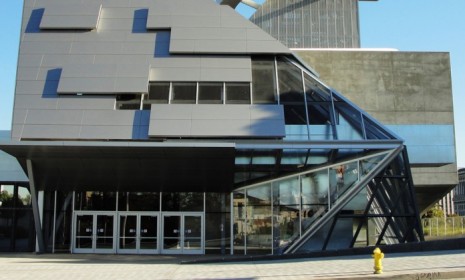America's most expensive public school: What $578 million buys
L.A.'s historic Ambassador Hotel — site of Robert F. Kennedy's 1968 assassination — has been replaced with the country costliest public school campus

The Los Angeles Unified School District is nearing completion of a new $578 million public school campus on the site it cleared by razing the storied Ambassador Hotel, where Robert Kennedy was assassinated in 1968. When it opens, the Robert F. Kennedy Community Schools will be the most expensive public school in the U.S. — and one of the most controversial of the nation's so-called "Taj Mahal" schools, given that the struggling school district has been forced to lay off nearly 3,000 teachers and slash programs in recent years. (Watch a local report about the school.) Here, a quick guide:
What does $578 million buy you?
The 24-acre RFK campus will include seven different schools that will serve 4,260 K-12 students. It also features a sizable park, a state-of-the-art swimming pool, underground parking, "talking" benches that recall the site's historical significance, and a marble memorial to Kennedy. The buildings will include restored or recreated sections of the 1921 hotel and the Cocoanut Grove nightclub, where artists like Frank Sinatra sang for Hollywood royalty.
The Week
Escape your echo chamber. Get the facts behind the news, plus analysis from multiple perspectives.

Sign up for The Week's Free Newsletters
From our morning news briefing to a weekly Good News Newsletter, get the best of The Week delivered directly to your inbox.
From our morning news briefing to a weekly Good News Newsletter, get the best of The Week delivered directly to your inbox.
What was preserved?
A wall of the Cocoanut Grove, and the coffee shop, originally designed by noted architect Paul Williams and now used as a teachers' lounge. The auditorium is a recreation of the Cocoanut Grove nightclub, and the library is a modified replica of the Ambassador's ballroom.
Who's paying for the school?
The school district (thus taxpayers), through a $20 billion construction bond approved by voters.
A free daily email with the biggest news stories of the day – and the best features from TheWeek.com
Why has it cost so much?
The original $400 million estimate was thwarted by a 2006-07 spike in raw building materials, the school district says, and it had to pay $9 million in legal battles with preservationists who wanted the Ambassador kept intact and with Donald Trump, who wanted to build the world's tallest skyscraper on the site. Another $15 million went into historical preservation, and $33 million was needed to install a methane mitigation system.
What other schools are in the $100 million-plus club?
RFK will cost about $135,000 per seat, but just last year L.A. also completed a $232 million Visual and Performing Arts High School that cost $132,000 per seat. In 2008, L.A. Unified opened the $377 million Edward R. Roybal Learning Center. Other so-called Taj Mahal schools are found in New York City ($235 million), New Brunswick, NJ ($185 million), and Newton, MA ($197.5 million).
Is RFK Community Schools worth the money?
It depends on who you ask. School board member Steve Zimmer says "if the true cost were $250,000 a seat, it would be worth every penny." On the other hand, Ben Austin of Parent Revolution says that "parents aren't fooled" by a fancy new building that's "run by the same people who've given us a 50 percent dropout rate."
How does it look?
"Confused, expensive, and a little macabre all at the same time," says L.A. Times architecture critic Christopher Hawthorne. Rather than creating "ersatz" and "kitschy" versions of the hotel and nightclub, he says, the school district should have either restored the original buildings to use as schools or created a bold, new complex unmoored to the past. The building may have its faults, says Joe Agron, editor-in-chief of the journal American School & University, but at least "there's no more of the old, windowless cinder-block schools of the '70s where kids felt, 'Oh, back to jail.'"
Sources: LA Daily News, AP/Huffington Post, LA Times

